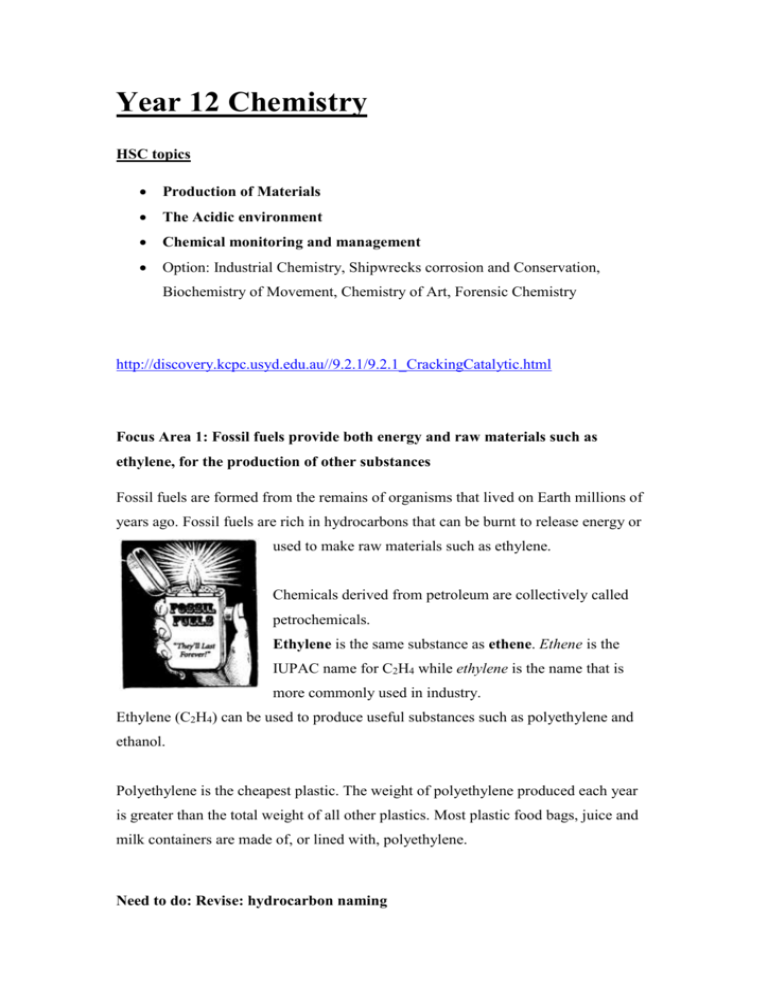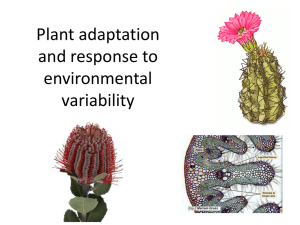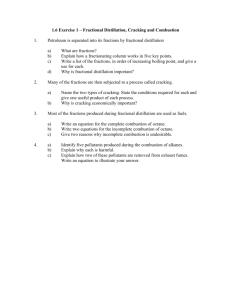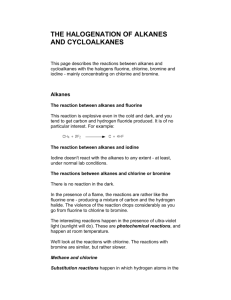Year 12 Chemistry2
advertisement

Year 12 Chemistry HSC topics Production of Materials The Acidic environment Chemical monitoring and management Option: Industrial Chemistry, Shipwrecks corrosion and Conservation, Biochemistry of Movement, Chemistry of Art, Forensic Chemistry http://discovery.kcpc.usyd.edu.au//9.2.1/9.2.1_CrackingCatalytic.html Focus Area 1: Fossil fuels provide both energy and raw materials such as ethylene, for the production of other substances Fossil fuels are formed from the remains of organisms that lived on Earth millions of years ago. Fossil fuels are rich in hydrocarbons that can be burnt to release energy or used to make raw materials such as ethylene. Chemicals derived from petroleum are collectively called petrochemicals. Ethylene is the same substance as ethene. Ethene is the IUPAC name for C2H4 while ethylene is the name that is more commonly used in industry. Ethylene (C2H4) can be used to produce useful substances such as polyethylene and ethanol. Polyethylene is the cheapest plastic. The weight of polyethylene produced each year is greater than the total weight of all other plastics. Most plastic food bags, juice and milk containers are made of, or lined with, polyethylene. Need to do: Revise: hydrocarbon naming Identify the industrial source of ethylene from the cracking of some of the fractions from the refining of petroleum Fractional distillation of crude oil is used to separate it into its fractions. The consumer demand for these different fractions does not match the proportions in crude oil as shown below. Fraction % in crude oil % by consumer demand Petrol 35 45 Diesel 25 27 Kerosene 20 <5 Bitumen 2 10 The demand for petrol exceeds supply produced by fractional distillation of crude oil. Petroleum is a mixture of hydrocarbons. When petroleum undergoes fractional distillation, some fractions, particularly petrol, are in demand and of high economic value. Other fractions, consisting of larger molecules than in petrol and of low value, can be passed over a heated catalyst that cracks the larger molecules into smaller molecules. A major by-product of this catalytic cracking is ethylene, also known as ethene. Catalytic cracking is the process in which high molecular weight fractions from crude oil are broken into lower molecular weight substances in order to increase the output of high demand products. Cracking can occur at lower temperatures (500OC) by using a zeolite (crystalline aluminosilicate substance) catalyst. The gaseous fraction is absorbed by the zeolite, weakening the bonds and reducing Ea (activation energy). -eg- C18H38 (g) zeolite 4 CH2=CH2 (g) + C10H22 (g) Steam cracking converts ethane and propane into ethene. The ethane (from natural gas deposits) and steam are passed (at around 900OC) through very hot metal tubes to decompose the alkanes. -eg- C2H6 (g) CH2=CH2 (g) + H2 (g) C3H8 (g) CH2=CH2 (g) + CH4 (g) Copy Down Example of cracking (shown below) Homework Questions- Week 1 1. Describe the composition of petroleum 2. When petroleum undergoes distillation, fractions are produced. Identify some of these. 3. Define fractional distillation 4. Use a diagram to show the industrial process of fractional distillation of petroleum. 5. Identify the IUPAC name for ethylene 6. Construct the structural formula for ethylene. 7. Outline the main source of ethylene. 8. Ethene is produced by the cracking of petroleum fractions. Describe the process of cracking. identify data, plan and perform a first-hand investigation to compare the reactivities of appropriate alkenes with the corresponding alkanes in bromine water Alkanes undergo substitution reactions Alkenes undergo addition reactions as they have reactive double bonds Bromine water is a yellow-brown colour, as it reacts with a hydrocarbon the yellow brown colour disappears leaving a clear solution. Aim: To compare the reactivity of an alkane and an alkene. Materials: 4 Test tubes Bromine water (BrOH) Alkane (cyclohexane C6H12) Alkene (cyclohexene C6H10) Fume Cupboard Justify the use of these materials Hypothesis Hints: Cyclohexane and cyclohexene are both colourless liquids. Is this important? You could also compare the toxicity of these cyclic hydrocarbons and similar straight chain hydrocarbons. Why is bromine water used here? Will is show a different reaction rate for an alkane and an alkene. Hints: From the theoretical knowledge of alkanes and alkenes, predict which will be more reactive and write this as a statement that can be tested. Variables: identify the following variables in the experiment Independent variable Dependent variable Controlled variables Hint: this is the one thing you change in Hint: This is what you measure or Hint: these are the things that must your experiment. observe to see the reaction. remain the same throughout the experiment. Risk Assessment: (MSDS- material safety data sheet) Before you carry out the experiment you must carry out a risk assessment. This identifies any risk involved by using the equipment you are using. Chemicals and equipment Risk Describe the precaution Explain the precaution Bromine water Toxic and corrosive Use a fume cupboard, Prevent toxic substances goggles and gloves. Work in being ingested, splashed into a well ventilated area. Do not the eyes or contacting the discard in the skin but place skin. in an organic waste disposal. Toxic substances would enter the environment and could enter the food chain and cause poisoning. Cyclohexane Toxic, harmful if swallowed Cyclohexene Method: Follow the procedure and note any modifications you make. 1. Carry out this procedure in a fume cupboard and wear gloves and safety goggles. 2. Pour 1 mL cyclohexane into each of 2 test tubes labeled A and B. 3. Pour 1 mL cyclohexene into each of 2 test tubes labeled C and D. 4. Cover test tubes A and C so they are in the dark. 5. Place test tubes B and D in the sunlight. 6. Add 5 drops bromine water to each test tube. 7. Tap the side of the test tube gently to mix the contents. 8. Observe any colour change. Results: Hint: Describe any colour changes observed in each test tube and how long it took for the colour to change. Remember that you must always describe results as changing form one colour to another. Do not use the word ‘clear’ when you mean colourless. Test Tube Initial colour of Initial colour of Colour after hydrocarbons bromine water bromine water added to alkene/alkane A B Time for change C D Write equations in words and symbols. Discussion: Account for your results: Hint: Were they what you expected? Comment on the accuracy of your results. Hint: Could the colour change be readily observed? Were the same quantities of chemicals used in each test tube to allow for accurate results? Comment on the reliability of your results Hint: Was the experiment carried out more than once to check if the results were reliable. Comment on the validity of your investigation Did the design of your experiment allow you to test what you set out to test? Did you have a control? Conclusion: Complete the following statements to write a conclusion for this experiment. You must make sure that your conclusion answers your aim and hypothesis. The results support/ do not support the hypothesis. The alkene, cyclohexene, reacted quickly/slowly with bromine water, changing colour from __________ to _________. This happened even in the light/dark. The alkane, cyclohexene, reacted quickly/very slowly with bromine water in the dark/light and did not react when in the light/dark. Reactions of Alkanes and Alkenes. There are only 2 important reactions: 1. Combustion: alkanes burn in air to form carbon dioxide and water and as part of the process a large amount of heat is released. Example: C3H8 (g)+ 5O2 (g) 3CO2 (g) + 4H2 O (g) 2. Alkanes such as ethane undergo substitution reactions. This is a reaction in which an atom is substituted for another already in the molecule, e.g. A hydrogen atom may be replaced with a halogen atom. Light energy is required. Example: CH4 (g) + Cl2 (g) CH3Cl (g) + HCl (g) identify that ethylene, because of the high reactivity of its double bond, is readily transformed into many useful products Ethylene is a more reactive molecule than ethane or other alkanes. The high reactivity of its double covalent bond that allows it to be chemically transformed into a wide variety of useful products. There are many substances which react with alkenes by opening out the double bond to form two single bonds: these are called addition reactions. Cyclohexene 1,2dibromocyclohexane Products derived from ethylene: Product Use Polyethylene Plastic film, crates and pipes Ethylene dichloride Raw material used to make the vinyl chloride monomer for PVC production Polyvinylchloride (PVC) Plastic pipes, guttering, soft furnishings Ethanol Solvent, fuel and drinks Ethylene glycol Antifreeze Polystyrene Plastic packaging, insulation 1,2-dibromoethane Petrol additive Chloroethane Solvent, refrigerant Reaction of ethene with water to produce ethanol- industrially this reaction is performed at high pressure at 300C and using phosphoric acid as a catalyst. Ethanol belongs to a group called alkanols, they can be regarded as alkanes with one H atom being replaced by an OH group. Ethanol is widely used as a reactant and a solvent in the synthesis of products ranging from pharmaceuticals to nail varnishes and plastics. Write a balanced equation for the reactions of (i) hydrogen (using a catalyst) (ii) chlorine (iii) bromine water a. propene b. 2-butene c-c=c-c identify that ethylene serves as a monomer from which polymers are made identify polyethylene as an addition polymer and explain the meaning of this term What is a monomer? (need to type out notes that are in folder) Paperclip- monomer, paperclip chain- polymer What is a polymer? Examples: outline the steps in the production of polyethylene as an example of a commercially and industrially important polymer Use textbook page 13-15 to complete table comparing LPDE and HDPE identify the following as commercially significant monomers: vinyl chloride - styrene by both their systematic and common names See notebook presentation, also used modeling kits. describe the uses of the polymers made from the above monomers in terms of their properties Bring in examples of polymers, and in terms of their properties. analyse information from secondary sources such as computer simulations, molecular model kits or multimedia resources to model the polymerisation process Use modelling kits. http://www.lbl.gov/MicroWorlds/Kevlar/KevClue1Act1.html Focus Area 2: Some scientists research the extraction of materials from biomass to reduce our dependence on fossil fuels Assignment: Alternatives to petrochemicals Condensation polymer- what is and reaction involved in Cellulose as and example Focus area 3: other resources such as ethanol are readily available from renewable resources such as plants Focus area 4: oxidation-reduction reactions are increasing important as a source of energy Focus area 5:nuclear chemistry provides a range of materials






